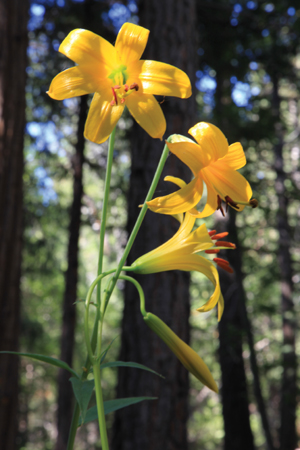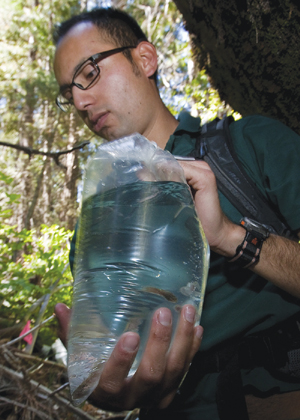The fragile ecosystem in the Southern California Mountains must maintain a delicate balance to protect itself from dramatic changes threatening the survival some species of frogs and plants.
The lemon lily plant and the mountain yellow-legged frog are two examples of species struggling to survive and efforts have been put into place to hopefully see future populations of the plant and frog thrive again in or near the beautiful mountain creeks in Idyllwild.

The endangered lemon lily is a gorgeous fragrant flower native to Idyllwild. It now has its own month of appreciation in July thanks to the rallying efforts of Idyllwild citizens who held the first Lemon Lily Festival with great success last summer.
“This year we plan to double our numbers and make the Lemon Lily Festival one of Idyllwild’s largest community events,” said Doug Yagaloff, one of the festival organizers and a member of the Idyllwild Business Roundtable. Organizers expect the festival to draw about 8,000 people this year.
The Idyllwild Nature Center has more than 100 bulbs that are in the early stages of budding, he said.
“In June, there should be thousands of lemon lilies along Strawberry Creek in Idyllwild,” said Yagaloff, thanks to a growing program.
The organizers of the second-annual, 3-day educational festival are hopeful that this will bring awareness and attention to saving the lemon lily and restoring the native population, Yagaloff said.
Lemon Lily Festival
July 15-17
At various locations including Idyllwild Nature Center and Town Hall
Visit: lemonlilyfestival.com
The mountain yellow-legged frog
The mountain yellow-legged frog is one of three frogs or toads on the federal Endangered Species list and has recently been proposed for listing under the California Endangered Species Act. Today, only a small wild population of less than 200 adult mountain yellow-legged frogs can be found in the San Gabriel, San Bernardino and San Jacinto mountains.
The effort to save the mountain yellow-legged frog has been underway for several years. Agencies, including the U.S. Forest Service, U.S Fish and Wildlife Service, U.S Geological Survey, the California Department of Fish and Game, the California Department of Transportation and the San Diego Zoo have all joined the effort.
Watching the wild population of mountain yellow-legged frogs disappear was frightening for researchers until they found a way to breed the frogs in captivity, said Frank Santana in an earlier interview with the Idyllwild Town Crier newspaper. Santana is a research technician with the San Diego Zoo Institute for Conservation Research and a primary researcher on the mountain yellow-legged frog project.
Experts say the decline in the frog population is due to habitat loss, the effects of climate change, pesticides, pollution, the introduction of non-native species in the past and the spread of a deadly pathogen called the chytrid fungus, Santana said.
“The fungus is the biggest cause of the decline and wiped out the frog population,” Santana said.
A team at the James San Jacinto Mountains Reserve is nurturing tadpoles. Santana said the tadpoles will not develop into fully grown frogs until spring 2012 and will not be able to breed for up to three years. One reason for the decrease in the mountain yellow-legged frog populations in the San Jacinto Mountains is the increase in hiking along the streams in the species’ natural habitat, officials said.
“The increase of people was having a drastic effect on the frog populations,” said Becca Fenwick, director of the James Reserve, in an earlier interview with the Town Crier. Fenwick said she is optimistic that the new restricted access to streams and large signs posted near creeks to educate the public is helping the frogs.
The tadpoles released last fall were bred at the San Diego Zoo Institute for Conservation Research (the largest zoo-based conservation effort in the world, founded in 1975) and cautiously transported to the James Reserve, which is part of the University of California Natural Reserve System. It was the first time captive-bred offspring of this species was introduced into the wild, officials said.
The tadpoles were released into the stream after the first snowfall and they naturally hibernated for the entire winter. The researchers began checking on how the tadpoles adapted this spring.
People can help wildlife populations survive and thrive by conserving water in nature, being cautious about dumping pollution into the environment, staying out of creeks and streams and heeding restricted notices and closures.













